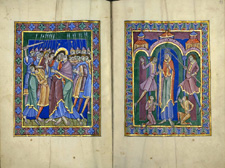Image
© Hildesheim, St Godehard |
THE MOCKING
OF CHRIST
Mark 14:65; Luke 22:64; Mark 15:17-20; Matthew 27:28-29
Christ is blindfolded, wearing the crown of thorns. He wears a red cloak
with purple lining. The tormentor on the left spits in his face and places
a rod, or mock sceptre, in his hand. The man on the right hits his head
with a stick. At his feet, two others kneel in mock adoration.
This scene is a literal depiction of two episodes from three sources:
the blindfolding and mocking before Peter’s denial (Mark 14:65,
Luke 22:64) and the scene after the interview with Pontius Pilate where
the crown of thorns and purple robe are placed on Christ (Mark 15:17-20
and Matthew 27:28-29). A close adherence to the text is significant because
the composition of the scene with the blindfolded Christ is new. It makes
a poignant parallel with the Presentation at the Temple (p28),
also symmetrical with Christ at the centre. In the earlier scene Christ
is flanked by maidens bringing doves of sacrifice; here he is flanked
by tormentors and he is the sacrifice.
Mark: ’And some began to spit on him, and cover his face and to
buffet him….[Later] And they clothed him with purple and platted
a crown of thorns , and put it about his head. And began to salute him,
Hail, King of the Jews! And they smote him on the head with a reed, and
did spit upon him, and bowing their knees worshipped him’.
Luke, after Peter’s denial:‘And when they had blindfolded
him, they struck him in the face’
Matthew, after Pontius Pilate: ‘And they stripped him and put on
him a scarlet robe. And when they had platted a crown of thorns, they
put it upon his head, and a reed in his right hand; and they bowed the
knee before him, and mocked him, saying Hail, King of the Jews!’.
The iconic and ritualised coronation which is depicted here derives from
Middle-Byzantine sources, such as Paris, Bib. Nat. Gr.74, f55v. The western
alternative showed more narrative action with Christ being dragged along
by tormentors.
The feature of the blindfold which Pächt considered to be an innovation
by the St Albans artist becomes more frequent in later Flemish and German
works by , for example, Pol Limburg and Grünewald. The blindfold
has clearly appeared in this psalter because the artist has looked at
two separate episodes in the gospels.
(AP, 61-2, 90, pl 114)
Quire 3.
Thread or stitch holes for protective curtain

Click
to enlarge
|
![]()